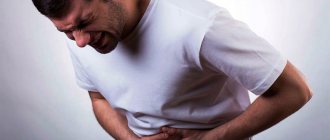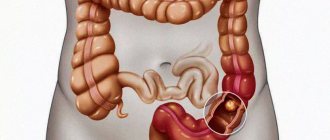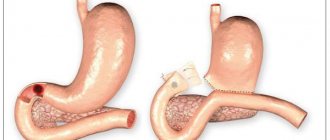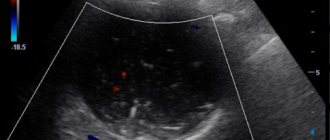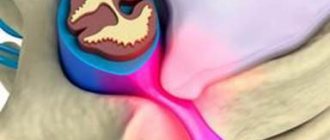Spastic colitis - what is it?
Spastic colitis is a persistent disorder of the functional state of the intestine. The pathology is accompanied by the occurrence of painful spasms. The disease does not provoke organic disorders in the organ. A characteristic manifestation of this type of colitis is a dystrophic change in the tissues of the digestive tract. The inflammatory process is less pronounced than in other forms of diseases in this category.
In women, spastic colitis is diagnosed more often than in men. The risk group also includes children (from an early age).
Causes
The main cause of the development of spastic colitis is considered to be a violation or lack of diet. Some foods have a negative effect on the mucous membranes of the digestive organs. When they are regularly consumed as food, the functional state of the digestive tract is disrupted. In combination with a decrease in the body’s protective functions, this factor provokes spasms of smooth muscles. The consequence is spastic colitis.
Other reasons:
Stress and neurotic disorders are the main risk factors for the development of spastic colitis.
- consequences of hormonal imbalance in the body;
- complications of allergic processes;
- hereditary predisposition;
- infection of the digestive system by parasites;
- excessive sensitivity of the digestive organs;
- lack of diet;
- consequences of regular stressful situations;
- complications after surgery in the digestive system;
- disorders of the body's immune system;
- excessive consumption of fatty and fried foods, coffee, alcohol;
- non-compliance with sanitary and hygienic standards;
- consequences of injuries to the digestive tract;
- disturbances in the functional state of intestinal tissues;
- abuse of bad habits;
- uncontrolled use of certain types of laxatives;
- regular constipation;
- uncontrolled antibacterial therapy.
Forms of the disease
Spastic colitis has several forms of manifestation. Each type of disease differs in provoking factors, additional symptoms and implies a special treatment regimen.
You can identify some forms of pathology yourself, but only a specialist can make an accurate diagnosis through a comprehensive examination of the patient.
Forms of the disease:
- acute type (the main cause of development is an infectious lesion of the digestive tract, or irritation of the intestinal mucous membranes by harmful substances);
- chronic type (is a consequence of the acute form, dysbacteriosis may be a concomitant condition);
- toxic type (the provoking factor is the effect of chemicals on the intestinal mucous membranes);
- allergic type (is a complication of chronic allergic reactions);
- nutritional type (develops due to a lack of fiber in the diet, regular violations of the diet);
- medicinal type (in most cases develops against the background of uncontrolled use of laxatives and antibiotics).
Additionally, in medical practice another classification of spastic colitis is used. There are different forms with a predominance of constipation, diarrhea, or alternation of these conditions. A separate group includes unclassified colitis. This type of pathology is difficult to diagnose. Symptoms can change quickly. It is not possible to identify the predominant symptoms.
Enterocolitis
A characteristic symptom of enterocolitis is plaque on the tongue.
In terms of its symptoms, enterocolitis is very similar to acute gastritis, but has a completely different origin.
Based on the type of pathogen, doctors distinguish two types of this disease: infectious and non-infectious.
In the latter case, the cause of the development of the disease is not harmful microorganisms, but ordinary poisoning or allergies.
In its form, enterocolitis can be acute or chronic. The disease of the first type affects exclusively the intestinal mucosa, while the second can also affect deeper tissues of the organ. As a result, it is chronic enterocolitis that especially often leads to functional digestive disorders.
As for the characteristic symptoms, abdominal pain, diarrhea, nausea and vomiting are typical for the disease described. A specific coating on the tongue also helps to diagnose enterocolitis. Most patients also complain of general signs of intoxication. Moreover, curiously, all of the listed symptoms are characteristic of both acute and chronic enterocolitis during periods of exacerbation.
Symptoms
The main symptom of spastic colitis is the presence of paroxysmal pain in the patient in the area of the digestive organs. The condition occurs regularly throughout the day and night. Spasms weaken after defecation. The clinical picture is complemented by other abnormalities in the digestive tract and a deterioration in general well-being. The intensity of symptoms depends on the degree of progression of the inflammatory process.
Other symptoms:
Symptoms of spastic colitis.
- flatulence accompanied by pain;
- disruption of the bowel movement process (diarrhea, constipation);
- spasms occur on an empty stomach or immediately after eating;
- regular false urge to defecate;
- excessive gas formation and rumbling in the stomach;
- lack of appetite (the sight of food causes nausea);
- belching with air (in the presence of complications - with acid);
- irregular bowel movements (constipation may be followed by diarrhea);
- heavy coating on the tongue, bitterness in the mouth, unpleasant odor from the oral cavity;
- overly tense abdominal muscles;
- feeling of incomplete bowel movement after bowel movement.
A distinctive feature of spastic colitis is the absence of elevated body temperature and a sharp decrease in body weight. Blood and mucus in the stool are also optional symptoms. These conditions arise under the influence of concomitant pathological processes. For example, if a patient develops a peptic ulcer or gastritis simultaneously with spastic colitis.
Signs of catarrhal colitis in men and women
The clinical picture depends on the form of colitis.
Manifestations of acute colitis:
- periodic sharp pain in the abdomen. Possible back and lower back pain due to colitis;
- constant urge to defecate;
- rumbling in the large intestine;
- bloating;
- severe diarrhea.
Manifestations of chronic colitis:
- feeling of fullness and heaviness in the stomach;
- pain in the form of colic (contractions) - these are mainly signs of spastic colitis;
- urge to defecate;
- diarrhea – when the right half of the large intestine is affected;
- constipation – if the left half is affected;
- fecal stench – observed when putrefactive flora is activated;
- flatulence (bloating) – observed when fermentative flora is activated;
- blood in the stool - detected in erosive or ulcerative colitis. This is a sign that requires a serious approach to treatment - for example, ordinary antibiotics or suppositories for deep erosive colitis simply will not help.
With long-term colitis the following are observed:
- significant weight loss;
- general weakness;
- manifestations of a lack of vitamins - dry skin and mucous membranes, blurred vision, and so on.
Menstruation may also change with colitis in women - they may become painful.
Acute and prolonged chronic colitis requires hospital treatment. Mild forms of chronic colitis can be treated at home.
Features of the disease in children
The main causes of spastic colitis in children are bacterial and infectious lesions of the digestive system. Unlike adult patients, children may have a rise in body temperature during an exacerbation. Pain in the abdomen provokes constant crying and irritability of the child. Impurities of mucus and blood in the stool appear faster than in adults with a similar diagnosis.
Features of spastic colitis in children:
- in childhood, the main cause of the development of pathology is the impact of psychotraumatic factors;
- the second common cause of colitis in children is considered to be complications after infectious or bacterial damage to the digestive organs;
- bottle-fed children (as well as weakened babies) are at risk;
- extraintestinal manifestations of spastic colitis in children may include headaches, difficulty swallowing, excessive sweating, heartburn, nausea and signs of tachycardia.
In children, spastic colitis is often accompanied by diarrhea alternating with constipation.
Causes of colitis. Types, classification
Treatment for ulcerative colitis in adults and its other forms is different. To differentiate them, a classification has been developed that systematizes colitis.
According to the course of colitis there are:
- acute – the symptoms are vivid, grow quickly, and cannot be confused with the symptoms of other diseases;
- chronic – develops slowly, symptoms are not expressed. Periods of remission (no signs) alternate with periods of exacerbation.
Depending on the cause, the following colitis is distinguished:
- ulcerative - its causes are not clear. This colitis is associated with hereditary factors, autoimmune and infectious lesions;
- infectious - develops under the influence of infectious agents - nonspecific (staphylococci, streptococci) and specific (Koch bacillus, treponema pallidum). The symptoms of nonspecific colitis in a child and an adult are similar;
- ischemic – occurs due to impaired microcirculation in the intestinal wall and its oxygen starvation;
- toxic - formed due to the influence of various toxic substances on the mucous membrane of the large intestine. A variety is medicinal colitis;
- radiation – develops due to the influence of radiation factors on the intestinal mucosa.
More information about the causes of colitis (for example, what are the causes of pseudomembranous colitis) can be found on the pages of our website https://www.dobrobut.com/.
Depending on the location of the lesion, the following colitis is distinguished:
- typhlitis – the cecal mucosa becomes inflamed;
- transversitis - the mucous membrane of the transverse colon suffers;
- sigmoiditis – the mucous membrane of the sigmoid colon becomes inflamed;
- proctitis – inflammation of the rectal mucosa;
- pancolitis - the mucous membrane of all parts of the large intestine is affected (for example, with catarrhal colitis in men or women).
Diagnostics
To diagnose spastic colitis, a comprehensive examination of the patient is necessary. If you have symptoms of the disease, you should contact a gastroenterologist. After a visual examination of the patient, compiling a list of complaints and palpation of the abdomen, the doctor prescribes the procedures necessary to determine the cause of the condition.
The set of diagnostic measures includes laboratory studies of biological material and instrumental procedures.
Laboratory research methods
The subject of laboratory tests for suspected spastic colitis is stool, urine and blood. Biological material is studied for the presence of parasites, signs of the inflammatory process and deviations in the level of vital substances. Laboratory tests are a mandatory step in diagnosing the disease.
Laboratory methods:
- general blood analysis;
- blood chemistry;
- examination of stool for helminth eggs;
- examination of stool for blood and mucus;
- blood test for celiac disease;
- coprocytogram.
Anorectal manometry analysis.
Instrumental research methods
The list of instrumental examination methods depends on the general clinical picture of the patient’s health status. In some cases, an ultrasound, x-ray or CT scan of the intestine is sufficient to confirm the diagnosis.
To determine the extent of pathological processes in the digestive system, additional procedures are prescribed.
Instrumental methods:
- irrigoscopy;
- anorectal manometry;
- colonoscopy;
- Ultrasound of the pelvic organs;
- colon-fibroscopy;
- sigmoidoscopy;
- X-ray of the intestines;
- Ultrasound of the abdominal organs;
- sigmoidoscopy;
- CT scan of the intestines.
Colitis due to irritable bowel
Colitis: what is it?
Unlike IBS, colitis is an inflammatory disease that affects the intestinal wall.
Depending on the nature of the disease, acute and chronic colitis are distinguished.
Chronic colitis
It is believed that chronic colitis is diagnosed in half of people with digestive problems. A characteristic symptom is unstable stool: alternating constipation and diarrhea. In addition, loss of appetite leading to weight loss, nausea, belching, and a feeling of bitterness in the mouth may occur. The combination of such symptoms requires examination of the entire gastrointestinal tract. In this case, the disease can occur with or without periodic exacerbations of symptoms.
Acute colitis
Acute colitis has pronounced symptoms, which, as a rule, occur simultaneously with inflammation of the stomach or small intestine. In the acute form, aching, sometimes throbbing pain occurs, and unstable stools are supplemented by possible impurities of blood or mucus.
Depending on the cause, there are several types of acute colitis, but we will consider only those that occur most often.
Infectious colitis
It is provoked by certain types of bacteria, viruses and parasites. They can enter the body from the outside, for example, by drinking contaminated water or not thoroughly washing fruits and vegetables. With a high level of intoxication in the body, infectious colitis may be accompanied by nausea and fever.
Toxic or drug-induced colitis
Occurs against the background of self-administration of medications, especially antibiotics or laxatives. Manifested by symptoms of severe poisoning: fever, nausea and vomiting. Possible stabbing, cutting pain in the abdomen, headache, nausea, dizziness, weakness, and general malaise.
Differences between colitis and irritable bowel
| Comparison criteria | IBS | Colitis |
| Nature of the disease | An intestinal disease associated with impaired intestinal motility . | An intestinal disease associated with an inflammatory process in the intestines . |
| Symptoms | Symptoms of IBS do not include signs of poisoning and inflammation (fever, vomiting, etc.), as well as additional discharge/impurities in the stool (mucus, blood, etc.) | May be manifested by fever, vomiting, nausea. Possible rectal bleeding, mucus and blood in the stool. |
| Health care | If the diagnosis is known, then independent monitoring of the course of the disease is allowed*. | A doctor's supervision is required, especially during the acute period. Hospitalization to a hospital is often necessary. |
| Treatment | The cause of the disease is related to a person’s lifestyle, which is not always possible to change quickly. That is why symptomatic treatment plays an important role in the treatment of IBS . | As a rule, treatment is prescribed by a doctor. The goal of drug treatment is to eliminate inflammation and its consequences. |
| Complications | Does not increase the risk of serious complications, including cancer.2 | The inflammatory nature of the disease can lead to the development of complications such as bleeding and tissue necrosis. |
Treatment of spastic intestinal colitis
Therapy for spastic colitis includes conservative treatment and mandatory diet. The patient should be provided with the most comfortable conditions possible. Stressful situations, emotional tension or excessive fatigue can reduce the tendency to recover.
The therapy package must be drawn up by a doctor. Self-medication can cause serious complications.
Conservative treatment
Spastic colitis does not provoke organic changes in the digestive tract. This feature of the disease precludes the use of surgical treatment methods. The need for surgery arises only in the presence of concomitant pathologies or their complications. Functional bowel disorder is treated conservatively (with medication). A doctor should draw up a list of medications.
Examples of drugs:
- antispasmodics (No-Shpa, Drotaverine);
- enzyme agents (Mezim, Festal);
- antidiarrheals (Imodium);
- enterosorbents (Enterosgel, Polysorb);
- anti-inflammatory medications (Ibuprofen, Baralgin, Analgin);
- means for restoring intestinal microflora (Bifindumbacterin).
Video - Therapeutic diet (TABLE) No. 3 (Chronic inflammatory bowel diseases)
Folk remedies
Alternative medicine recipes are highly effective in treating spastic colitis. Decoctions and infusions based on herbal components can eliminate pain, restore intestinal motility, increase immunity and improve the functional state of the digestive tract as a whole. Such drinks are prepared using the standard method. A teaspoon of dry raw materials is poured into a glass of boiling water, the preparation is infused and consumed in small portions throughout the day.
Examples of folk remedies:
- decoctions with anti-inflammatory effects (sage, coltsfoot, chamomile);
- means for stabilizing the nervous system (melissa, peony);
- infusions to reduce gas formation (dill seeds, anise, fennel, mint);
- means to improve the process of bowel movement (rowan, buckthorn bark).
Diet and nutrition for spastic colitis
Correction of the diet is a mandatory step in the treatment of spastic colitis. Violation of the regime, consumption of harmful foods, frequent fasting or overeating are among the provoking factors for this disease.
A strict diet must be followed during the acute period of the disease. After the main symptoms subside and during the period of remission in chronic colitis, the diet is expanded. The diet can have a therapeutic effect. A properly formulated diet will accelerate the tendency to recovery. Diet principles can be used to prevent relapses of colitis.
Nutrition Features:
- Baked goods and other flour products are excluded from the diet (to eliminate fermentation processes in the digestive system);
- It is forbidden to eat fatty, salty, spicy, fried, pickled foods;
- exclusion from the menu of foods that cause excessive gas formation;
- It is recommended to replace milk and dairy products with fermented milk products.
Basic principles of nutrition
The principles of nutrition for spastic colitis depend on the symptoms of the disease. If the disease develops with a predominance of constipation, then the diet should include raw vegetables and fruits, baked beets and pumpkin, whole grain bread and dried fruits. If diarrhea is present, the rules change. Vegetables and fruits should be heat treated.
Products with a laxative effect are prohibited for consumption. The basic principles of diets for constipation and diarrhea are no different.
Diet principles:
- fractional meals (small portions, 5-6 times a day);
- compliance with the drinking regime (at least two liters of water per day);
- dishes should be free of dyes, preservatives and other harmful components;
- products should be high in calories, but easily digestible by the digestive system;
- if constipation predominates, the principles of Diet No. 2 should be followed;
- if colitis is accompanied by diarrhea, then the principles of Diet No. 4 are taken as the basis for nutrition.
Treatment
Diet. The main goal of the diet is to limit the consumption of spicy, fatty, salty and other foods that have an irritating effect on the intestines. In addition, you need to include the following foods in your diet: fruits, whole grain bread, beans, vegetables. It is recommended to eat fractional meals 5-6 times a day in small portions. This makes it possible to reduce the intensity of diarrhea, the level of gas formation, and stabilize the patient’s condition.
Drug treatment. Initially, treatment of spastic colitis begins with the prescription of non-steroidal anti-inflammatory drugs (NSAIDs) and antibacterial drugs. Well-known remedies are recommended: analgin, ibuprofen, baralgin, spasmalgon, ketorol. However, it must be remembered that their long-term use can provoke a worsening of the disease and ulceration of the gastrointestinal mucosa. Broad-spectrum antibiotics are also used: ceftriaxone, cefazolin, oxamp. In addition to anti-inflammatory drugs, the doctor prescribes enveloping drugs that help reduce the intensity of the inflammatory process.
To make an appointment at the ABC-Medicine clinic for the treatment of spastic colitis, call +7 (495) 223-38-83.
Possible complications and consequences
With spastic colitis there is no tendency for symptoms to increase. The disease significantly reduces the quality of life. The disease is not accompanied by organic disorders of the digestive tract. However, if the symptoms of the pathology are ignored for a long time, serious complications can arise. Diarrhea provokes dehydration, constipation causes intestinal obstruction. The consequences of such conditions are disruptions in the functioning of the entire body. With intestinal obstruction, pathological processes develop that require surgical intervention.
Prevention
Prevention of spastic colitis involves eliminating provoking factors. Intestinal motility can be disrupted by a sedentary lifestyle. If there is insufficient physical activity, it is recommended to do basic exercises in the morning.
The diet must be controlled. Frequent snacking, sudden changes in diet, overeating and other factors have a negative impact on the condition of the digestive system.
Prevention measures:
- prevention of stressful situations and timely treatment of nervous disorders;
- compliance with the rules of a balanced and rational diet;
- timely identification of the causes of gastrointestinal disorders;
- prevention of parasitic and bacterial infections;
- regular examination by a gastroenterologist;
- healthy lifestyle and sufficient physical activity;
- adherence to sleep and rest patterns.
Video - Super food for intestinal motility.
